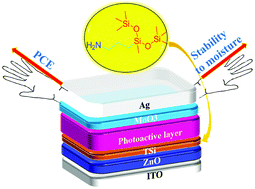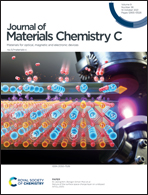Efficient and moisture-resistant organic solar cells via simultaneously reducing the surface defects and hydrophilicity of an electron transport layer†
Abstract
Organic solar cells (OSCs) simultaneously featuring good photovoltaic performance and strong humidity resistance are greatly anticipated for their practical application. Herein, we developed a simple organic trisiloxane molecule (denoted as TSi), and applied it to modify sol–gel ZnO (sg-ZnO) films. Compared to pristine sg-ZnO films, the TSi/sg-ZnO film presents fewer surface defects, shallower work function, and stronger hydrophobicity. Benefiting from those improved characteristics, when adopting a benzodifuran (BDF)-based polymer (BDFP-Bz) and Y6 as the electron donor and acceptor to fabricate OSCs, the derived devices utilizing TSi/sg-ZnO as the electron transport layer (ETL) showed suppressed charge recombination, enhanced charge extraction and increased stability to moisture versus the devices based on an sg-ZnO ETL. Meanwhile, PBDFP-Bz:Y6 OSCs based on a TSi/sg-ZnO ETL delivered a higher PCE of 14.62% than that of the control devices (12.39%). More importantly, the TSi/sg-ZnO ETL was also applicable in other different photovoltaic systems, among which PM6:Y6 OSCs based on a TSi/sg-ZnO ETL yielded a superior PCE of 16.37% along with stronger stability to moisture versus the reference ones. Our finding demonstrates the TSi/sg-ZnO bilayer ETL holds promise in the practical application of OSCs for simultaneously improving the photovoltaic performance and moisture-resistance of devices.



 Please wait while we load your content...
Please wait while we load your content...